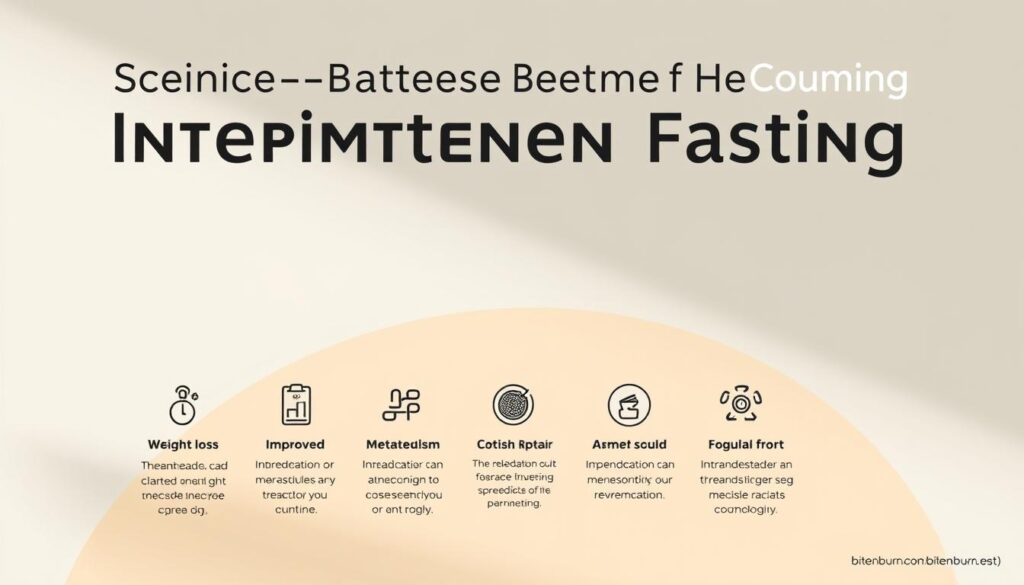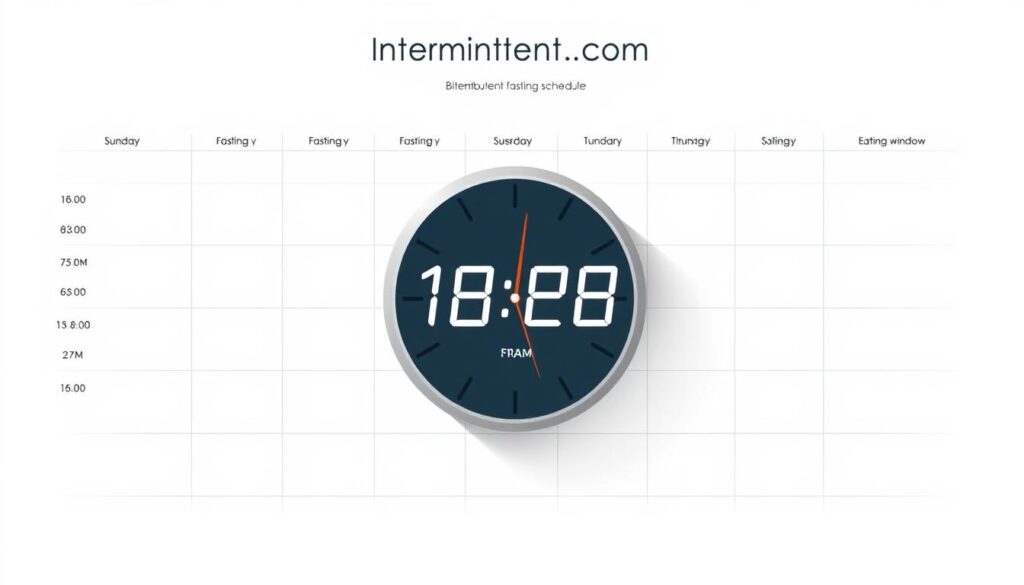In 2022, over 34 million Americans tried intermittent fasting. It’s a fast-growing health trend in the U.S. This isn’t just a diet; it’s a lifestyle change backed by science.
Intermittent fasting is about when you eat, not what. It helps people lose weight, boost energy, and improve health. This guide shows how these intermittent fasting benefits can meet your goals. Whether you want simpler meals, better mental focus, or better metabolic health, it’s for you.
Key Takeaways
- Intermittent fasting can improve metabolism and blood sugar control.
- Over 34 million Americans already embrace this approach.
- It’s not one-size-fits-all—methods like 16/8 or 5:2 adapt to lifestyles.
- Science shows it may reduce inflammation and support cellular repair.
- Benefits extend beyond weight loss, including mental clarity and longevity.
What Is Intermittent Fasting and Why Is It Popular?
Intermittent fasting is a way to eat that focuses on when you eat, not just what. It involves eating and fasting in cycles. This method has become popular, combining science with simplicity.
The Science Behind Eating Windows and Fasting Periods
When you eat, your body uses glucose for energy. When you fast, it burns fat. Studies show this can boost your metabolism and autophagy, the body’s natural cleanup.
- Fed state: Uses glucose for energy
- Fasting state: Burns fat stores
- Autophagy: Cellular repair activated during longer fasts
The Rising Popularity of Intermittent Fasting in America
“Intermittent fasting works because it adapts to real life, not the other way around.” – Dr. Jason Fung, expert in metabolic health
Books like The 8-Hour Diet and podcasts like The Model Health Show have raised awareness. Celebrities and athletes like Halle Berry and Tim Ferriss share their success. Now, over 30% of Americans practice intermittent fasting, according to a 2023 Healthline survey.
How Intermittent Fasting Differs From Traditional Diets
| Traditional Diets | Intermittent Fasting |
|---|---|
| Focus on calorie counting | Focus on meal timing |
| Rigid meal plans | Flexible eating windows |
| High dropout rates | Higher long-term adherence |
Unlike strict diets, intermittent fasting benefits include flexibility. You can choose meals within your window, making it easier to follow long-term.
The Science-Backed Benefits of Intermittent Fasting
Intermittent fasting isn’t just a trend—it’s backed by studies showing real intermittent fasting benefits. Research highlights improvements in heart health, brain function, and longevity. Let’s break down the facts.

- Heart Health: Studies show lower blood pressure and LDL cholesterol levels in those practicing fasting.
- Brain Power: Animal studies suggest fasting may boost brain-derived neurotrophic factor (BDNF), supporting cognitive performance.
- Longevity: Animal and human trials hint at cellular repair processes that could slow aging.
- Diabetes Prevention: Improved insulin sensitivity lowers type 2 diabetes risk by regulating blood sugar.
| Benefit | Key Finding | Study Reference |
|---|---|---|
| Heart Health | 10% average reduction in LDL cholesterol | Journal of the American Heart Association (2021) |
| Brain Function | Increased BDNF linked to better memory retention | Neurology Science Advances (2019) |
| Insulin Sensitivity | 15% improvement in insulin response over 12 weeks | Cell Metabolism (2020) |
“Intermittent fasting results often align with metabolic improvements seen in clinical trials.” – Dr. Satchin Panda, Salk Institute
While promising, results vary. Always consult a healthcare provider before starting. Evidence shows when done correctly, the intermittent fasting benefits can be transformative for many individuals.
How Intermittent Fasting Changes Your Metabolism
Intermittent fasting does more than just help you lose weight. It changes how your body uses energy. This eating pattern leads to intermittent fasting benefits by changing your metabolism.
Autophagy: Cellular Cleanup During Fasting
When you fast, your body starts autophagy. This is when your cells clean out old parts. It’s like a spring cleaning for your body. Research shows it might help prevent diseases like Alzheimer’s by getting rid of damaged proteins.
Metabolic Switching and Fat Burning
After 12-16 hours of fasting, your body starts burning fat instead of carbs. This switch is called ketosis. Here’s how it works:
- Glucose reserves run out after 8–12 hours of fasting.
- Your body uses stored fat for energy, making fat loss more efficient.
- Ketones provide steady energy without causing blood sugar spikes.
Hormone Regulation and Blood Sugar Control
Intermittent fasting lowers insulin levels. This makes your cells more responsive to insulin. It helps control blood sugar and lowers the risk of diabetes. It also increases growth hormone, helping keep muscle during fasting.
| Process | Description | Benefits |
|---|---|---|
| Autophagy | Cellular repair mechanism | Slows aging, reduces disease risk |
| Metabolic Switching | Fat burning instead of carbs | Enhanced weight loss, stable energy |
| Hormone Regulation | Insulin reduction, growth hormone rise | Improved metabolism, muscle preservation |
These changes are not just temporary. They lead to lasting changes in your metabolism. By understanding these changes, you can make your fasting routine more effective for your health.
Popular Intermittent Fasting Methods to Try
Choosing the right intermittent fasting methods depends on your goals and daily routine. These four plans offer flexibility and help you stay consistent. Let’s explore how each works and who they suit best.
The 16/8 Method: Most Common Approach
The 16/8 method is a great starting point. Fast for 16 hours a day, eating within an 8-hour window. For example, skip breakfast and eat between 12 PM–8 PM. This makes meal planning easy and is perfect for beginners.
- Eat within 8 hours (e.g., 10 AM–6 PM).
- Works with most diets (vegetarian, keto, etc.).
- Requires no calorie counting—just time-restricted eating.
5:2 Fasting: Weekly Calorie Restriction
On two non-consecutive days each week, eat 500–600 calories. Eat normally the rest of the week. This method is great for those who like structured plans. Keep track of meals on fast days to stay on track.
Eat-Stop-Eat: 24-Hour Fasting
Fast for 24 hours on one or two days a month. For example, finish dinner at 7 PM and start eating again the next evening. This method builds fasting tolerance without daily commitment.
Alternate Day Fasting: Advanced Technique
Alternate between normal eating days and zero or very low-calorie days. This intense approach demands careful planning to avoid overeating on non-fasting days. Ideal for those seeking rapid results but requires discipline.
Try out these intermittent fasting methods to see what fits your lifestyle. Remember to stay hydrated and eat balanced meals for the best results.
Intermittent Fasting for Weight Loss: Does It Work?
Intermittent fasting for weight loss is getting a lot of attention. Research shows it can help you lose body fat without counting calories too much. A 2022 study in the New England Journal of Medicine found it works just as well as regular diets.
“Intermittent fasting aligns with how the body naturally manages energy storage,” noted researchers analyzing metabolic pathways.
Three main reasons why intermittent fasting results are good:
- It helps you eat fewer calories without feeling hungry
- It makes your body better at using insulin, which helps with fat storage
- It boosts fat burning during fasting times
| Timeframe | Average Weight Loss |
|---|---|
| 8 weeks | 3-5% |
| 12 weeks | 5-8% |
| 6 months | 7-10% |

Results can vary based on your starting weight and how active you are. Some people lose weight quickly, while others see it more slowly. But, myths like “fasting causes muscle loss” are wrong. Proper nutrition keeps your muscles strong while fasting.
To get the best intermittent fasting for weight loss results, eat well and stay active. Success comes from sticking with it, not just fasting.
Creating Your Personalized Intermittent Fasting Schedule
Creating an intermittent fasting schedule that fits your life needs flexibility and knowing yourself. Start by noticing when you feel hungry or full. A good intermittent fasting plan balances health with your daily life.

Finding Your Ideal Eating Window
- Track hunger cues before and after meals to pinpoint optimal eating times.
- Early risers might thrive with morning-focused eating windows, while night owls may prefer evening meals.
- Test 16/8, 5:2, or other methods to see which fits your energy cycles best.
Adjusting for Lifestyle and Work Demands
Office workers can pair fasting with 9-to-5 hours, while shift workers might split meals strategically. For social events, plan eating windows around dinners or gatherings. Use apps like Zero or MyFasting to track adjustments without rigid rules.
Weekend vs. Weekday Schedules
“Consistency builds habits, but occasional flexibility prevents burnout.” – Nutrition Today Journal, 2023
Stick to stricter schedules on weekdays but allow relaxed weekends. Avoid extreme deviations to maintain metabolic benefits. Small adjustments—like extending eating windows on Saturdays—can keep plans sustainable.
Remember: The best intermittent fasting schedule adapts to your life, not the other way around. Prioritize habits you can maintain long-term.
Meal Planning Tips for Successful Intermittent Fasting
A smart intermittent fasting meal plan makes your eating window a time for balanced nutrition. Start by choosing whole foods like vegetables, lean proteins, and healthy fats. This keeps your energy steady. Also, pair this with a consistent intermittent fasting schedule that fits your daily routine.

- Breakfast Matters: Start with protein-rich foods like eggs or Greek yogurt to curb hunger.
- Portion Control: Use smaller plates to avoid overeating during meals. Split your calories evenly across 2-3 meals.
- Hydration First: Drink water or herbal tea before meals to signal fullness and stay hydrated.
- Prep in Advance: Meal prep healthy snacks like nuts or veggie sticks for scheduled hunger gaps.
Sample intermittent fasting meal plans vary by schedule. For a 16/8 method, try:
Lunch: Grilled chicken salad with avocado.
Dinner: Salmon, quinoa, and steamed broccoli.
Adjust portions if following 5:2 plans by cutting calories on fasting days. Vegetarians can swap proteins with lentils or tofu.
Track hunger cues and adjust portions gradually. Remember, a thoughtful approach to your intermittent fasting schedule helps maintain focus and prevents overindulgence. Small changes like these make all the difference in long-term success.
Common Mistakes to Avoid When Intermittent Fasting
Getting good at intermittent fasting is more than just timing your meals. Many newbies miss out on simple habits that can mess up intermittent fasting benefits. Stay away from these mistakes to keep on track.

Breaking Your Fast Incorrectly
Choosing the wrong foods after fasting can ruin your progress. Drinks like flavored lattes or sugary electrolyte mixes raise insulin levels, ending your fast. Stick to water, black coffee, or herbal tea to stay in fasting mode longer.
- Avoid: Sodas, fruit juices, or calorie-dense “fasting” bars
- Choose: Zero-calorie beverages or plain water
Not Drinking Enough Water
Dehydration can feel like hunger. Drink water or herbal tea during fasting times to fight cravings and aid detox. Aim for 64 ounces a day—hydration keeps your energy up.
Eating Too Much During Eating Windows
Bingeing during eating times messes up calorie balance. Overeating can upset digestion and cause weight gain. Eat balanced meals with protein, fiber, and healthy fats to feel full.
Other mistakes include jumping into extreme fasting too fast. Start with 12-hour fasts and then move up. Listen to your body—don’t ignore fatigue. Pair fasting with gentle exercise like walking, not intense workouts on an empty stomach.
Who Should Not Try Intermittent Fasting: Precautions and Contraindications
Intermittent fasting works differently for everyone. Some people should not try it at all. Before starting, certain groups need to talk to a healthcare provider first. Here’s who should be careful:
- People with type 1 diabetes or unstable blood sugar
- Pregnant or breastfeeding individuals
- Those with eating disorders or a history of disordered eating
- Adolescents still growing or underweight adults
- Individuals on medications requiring food intake
| Group | Risk Factors |
|---|---|
| Type 1 Diabetes | Risk of dangerous blood sugar drops |
| Pregnant/Breastfeeding | Nutritional needs for health |
| Eating Disorder History | Potential to worsen mental and physical health |
| Frail Older Adults | Risk of muscle loss or weakness |

Intermittent fasting can be harmful if it’s not right for your health. Signs like dizziness, extreme fatigue, or mood swings mean you should stop. Always talk to a doctor before starting. Your health is more important than following trends. Get advice tailored to you to make sure intermittent fasting is safe.
Top Intermittent Fasting Apps to Track Your Progress
Keeping up with intermittent fasting is simpler with the right apps. These tools help track your progress, send reminders, and analyze your journey. Let’s dive into what makes these apps useful.
Features to Look For in Fasting Apps
Good intermittent fasting apps have:
- Customizable fasting schedules
- Real-time progress charts
- Hydration and calorie trackers
- Mood and energy-level logging
- Guided fasting plans
Free vs. Premium Fasting Trackers
Free apps usually offer basic features like timers and logbooks. Premium options add:
- Advanced analytics and exportable reports
- Offline access and cloud syncing
- Exclusive community challenges
- Personalized nutrition advice
Apps like Zero and LIFE Fasting Tracker start free but offer more with a paid upgrade.
User Reviews of Popular Fasting Apps
People love Fastic for its simple design and 16/8 presets. Window is praised for letting you set your own eating times. BodyFast is unique with its photo journal for tracking progress.
Some free apps are missing reminders, but premium versions might have subscription costs.
Real Results: Success Stories and Transformation Journeys
Intermittent fasting results can vary, but many see big changes. Let’s look at real stories from those who tried it:
“After six months of 16/8 fasting, I lost 30 pounds without counting calories. My energy soared!” – Maria R., fitness enthusiast
| Name | Method | Time | Results |
|---|---|---|---|
| David M. | 16/8 | 8 months | 22 lbs lost + better sleep |
| Lauren T. | 5:2 Diet | 1 year | 18% body fat reduction |
| Carlos G. | Eat-Stop-Eat | 14 months | 40 lbs lost + improved blood pressure |
Many added healthier eating or exercise to their fasting. Carlos, for example, cut down on refined carbs and started walking. This boosted his intermittent fasting results. Others felt more focused or had less joint pain. These stories show fasting can be part of a bigger lifestyle change.
Keep in mind, results vary based on how consistent you are and your overall lifestyle. It’s okay if changes take time. Every journey is different. What’s important is finding a plan that works for you.
Conclusion: Is Intermittent Fasting Right for You?
Intermittent fasting can offer benefits like better metabolism and weight control. But, it’s not for everyone. Ask yourself if it fits your health goals and lifestyle.
Start with a 16-hour fast a few times a week. See how your body reacts. It’s not a strict diet but a way to make better food choices.
Think about how you feel about eating. If fasting makes you stressed or triggers bad habits, it’s not for you. Always talk to a doctor if you have health issues like diabetes or are pregnant.
Even if fasting isn’t for you, the idea of eating mindfully is still beneficial. Taking charge of your diet is a positive step. Your body will appreciate it.


[…] allies. They deliver phytonutrients that reduce inflammation and enhance cognitive clarity during fasting windows. More importantly, they satisfy cravings without spiking blood sugar. Imagine savoring a […]